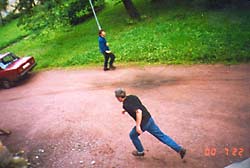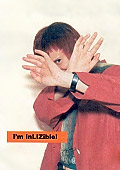 |







|
 |
ESCAPE programme (used to be called ESPACE till 1999) was created
by an artist Valeriy Ayzenberg in 1999. In the same year the artists
Bogdan Mamonov, Anton Litvin and Liza Morozova joined him.
In the
activity process the programme structure was defined, it
included joint projects of the programme members (ESCAPE group)
and ESCAPE gallery (exhibitions and performances of the group
members and some invited artists arranged within the gallery area
or on some other grounds).
 In typological terms the gallery activity can be attributed to the
international practice "artists run spaces", and besides
it sort of revives in a new context the Moscow tradition of Apt-Art
(Apartment Art). All the four programme members are curators of
gallery exhibitions.
In typological terms the gallery activity can be attributed to the
international practice "artists run spaces", and besides
it sort of revives in a new context the Moscow tradition of Apt-Art
(Apartment Art). All the four programme members are curators of
gallery exhibitions.
The gallery ESCAPE is located in the studio apartment of Valeriy
Ayzenberg (Nagornaya St., building 23 / 2). This is the place where
the first programme actions were held. Over five years there were
arranged 25 exhibitions altogether. With few exceptions these are
mostly experimental individual exhibitions of invited artists.
ESCAPE was originated as a response to monopolization of
the present-day art by a particular narrow circle of gallery owners,
curators and critics: new ways of competition inevitably encourage
development of new strategies. In this case the activity of an artistic
group proves to be more effective than an individual work of one
artist. But it should be mentioned that to the same extent the programme
was caused by the need for collective creative work experienced
by each group member.
The programme status allows to ESCAPE members to present themselves
irrespective of any institutions, to be a mobile unit and exhibit
their projects simultaneously in different areas.
 The
progamme strategy is based not on the search for an unoccupied
niche in the completely filled territory of post-modernist art,
but on closing up gaps between the existing niches. The aim is to
commit sort of communication "acts of terrorism" on the
area of Art, such meta-activity is similar to a computer virus operating
in the network. The
progamme strategy is based not on the search for an unoccupied
niche in the completely filled territory of post-modernist art,
but on closing up gaps between the existing niches. The aim is to
commit sort of communication "acts of terrorism" on the
area of Art, such meta-activity is similar to a computer virus operating
in the network.
The programme performance illustrating its name became "Escape"
(B. Mamonov, V. Ayzenberg, 2000). The performance was built on an
emphatic rejection of any contacts and consisted of a number of
"escapes" thus encouraging the spectators to more intimate
communication.
In August 2000 the ESCAPE gallery presented a new exhibition called
"Liza and the Dead" which initiated a new trend - none-spectacular
art. This practice as the last spark of Russian 20th century
avant-garde was a response to the art of 1990s which was seized
hostage by "mass media invocatory and indecent patency".
While denying visual and spectacle characteristics ESCAPE doesn't
deny figurativeness and shape. The task of the programme is not
to criticize the mechanisms of capitalistic society but to escape
to the maximum the representation as a type of faschizoid activity.
 The programme members regard the Artist and his life as the only
value of the Art world, that's why favorite ESCAPE genre
is a performance as "The Art of Life", and
one of main themes of their creative work is an analysis of programme
members' roles within the group and in the society, their images
and relationships ("XI.IX", "Beauty Free").
The analysis is full of serious content but at the same time has
sort of a self-mocking character.
The programme members regard the Artist and his life as the only
value of the Art world, that's why favorite ESCAPE genre
is a performance as "The Art of Life", and
one of main themes of their creative work is an analysis of programme
members' roles within the group and in the society, their images
and relationships ("XI.IX", "Beauty Free").
The analysis is full of serious content but at the same time has
sort of a self-mocking character.
One of ESCAPE aims is to achieve new and very personal relations
between the artist and the spectator. Such relations are being achieved
by having tea together with a spectator (project "Liza and
Dead"), playing football with him ("Zverev and Chirik"),
driving a spectator in a trolley around the exhibition hall ("Everything
you saw, but could not stop") or leading him by his hand with
his eyes blindfolded ("Motherland Exchange"). Here the
form of an artist existence almost merges with the reality.
The most important ESCAPE peculiarity consists in constant
changing of social function. Over 5 years it has performed not only
as a non-profit gallery, but as a store, a travel agency, a repair
shop and even as a Motherland acquiring office (" Motherland
Exchang"). For example at the International Art Fair "Art
Manege 2000" the programme members launched the stand repairing
straight in public. And at the fair "Art Moscow 2001"
they exhibited their personal belongings as works of art. In the
project "ESCAPE Travel Agency" the artists were selling
real tours to various parts of the world during these tours they
having taken the role of guides together with the spectator-tourists
held initiation performances opening a hidden reality thus trying
to turn a spectator into an artist.
The programme strategy keeps on developing. The variety of themes
is rather wide thus on one hand there are projects containing some
provocative elements (the projects "Interview" 2001, "
"They Know and They Like", 2002, "Pirates",
2003), but on the other hand there are projects that can be called
lyrical they center round the themes of human values and their place
in present-day society and culture (projects "Peace is but
a Dream", 2002 and "Quartett", 2003 shown at "Art
Moscow").
Today ESCAPE is one of the most active forces operating at the Moscow
art scene. The acknowledgement of its ascendancy has manifested
itself in a form of award "For achievements in the field
of present-day art". The award was presented to the programme
at the Workshops "Art Moscow 2003".
Thus success was attained by the group which has never worked with
any Moscow gallery, which has not enjoyed support of any large institution
and has not had any significant financial possibilities. Nevertheless
the programme participants have proved that today an artist is able
to attain success while remaining independent. Probably this is
the major ESCAPE achievement over the 5 years of its activity.
|
 |

